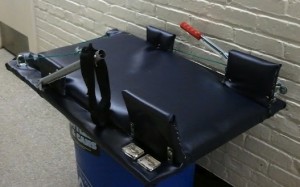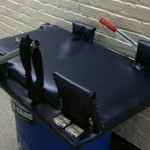Designers: Jeff Sechrist, Shrey Patel, and Brad Hubbard
Client Coordinators: Keith Jacobsen, PT
INTRODUCTION
The North Carolina Jaycee Burn Center at the UNC-Chapel Hill hospital provides burn care to both inpatients and outpatients. Depending on the location of the burn, a patient may experience decreased range of motion in their limbs due to the non-elastic nature of the newly grafted or burned skin. As a result, the patient must stretch the affected limbs at least 2 times a day, for up to an hour each time. This will stretch the damaged skin and recruit new areas of nearby healthy skin to facilitate this stretch, which helps to maintain and extend their range of motion. This time consuming exercise is currently being done in the clinic by a physical therapist (PT). However, this is not an efficient use of the PT’s time. In addition, when the patient is ready to return home, they no longer have daily access to the PT for these stretches and as a result, their range of motion may regress.
We developed a shoulder and arm stretching device that the patient can use independently, both in the clinic and at home. The device facilitates a particular stretch that the PT performs: a straight flexion of the arm, with the patient in a supine position and the arm moving back toward the head. The goal is to achieve full range of motion, which is a 180 degree angle between the torso and arm. Our device provides feedback of the current arm angle so that the patient can maintain and increase the range of motion. The device is easy and comfortable to use, which is important because patients can be sore from their burn.

Figure 1: The Final Stretch device. In this view, the head would rest on the left and the torso to the right, and the winch lever arm is positioned for left handed operation to crank the right arm back.
SUMMARY OF IMPACT
The device has been tested with different patients, both to increase and to maintain range of motion. One patient had prominent scar bands around her shoulder that needed to be stretched and the device was efficient in opposing the constricting force of her skin. Another patient already had full range of motion but needed to continue stretching exercises to maintain that range. After initial testing, Keith Jacobson, PT, commented that the “device allows the shoulder to undergo stretching in manner more comfortable for both the therapist and the patient”. Ralph Stoehr, PT, said that “is it nice that the patient can use it independently while having the ability to go up to a 180 degree stretch angle.” This frees the PTs to do other activities. Keith added that “the design of the device allows it to be easily portable and used on both shoulders”. The stretching device is also beneficial in the home setting.
TECHNICAL DESCRIPTION
The device is used either on the floor or on a bed and the patient lays in the device in a supine position, their legs extending off of one end. Their affected arm rests in a cuff at the end of a rotating rod, with a center of axis of rotation that is next to the shoulder joint. At the start of the stretch, the arm is pointing vertically toward the ceiling. Then, the patient cranks a winch mechanism, which pulls on a cable that then pulls on the rotating rod to slowly pull their arm back. The winch will hold the position for an extended period of time, until the patient, clinician, or their caregiver is ready to release it.
The base of the device is a 2×3 ft plywood board with foam cushioning and vinyl upholstery for comfort and easy cleaning. The winch (Haul-Master) is attached to the board with acrylic groove mounts. The user operates the winch by alternately pulling and pushing a lever using their healthy arm. For the cable, we used a stranded metal cable with plastic sheathing. The cable enters the pulley system that is mounted on the base, which translates the cable around the user’s head to the affected side. In this manner, the patient can use their healthy arm to increase the range of motion of their affected side. The winch has a release mechanism that releases tension on the cable so that the user can move their arm back into a resting position next to their torso.
The rotating rod was attached to a hinge on the board that allows it to swivel freely in the desired direction. The arm can be secured to the far end of the rod in a variety of ways, depending on the patient’s injury. One option that we designed is hard-shell arm cuff made from a padded half-pipe of PVC hinged to another half-pipe. The two half-pipes are brought together to form a 4” diameter cylinder that surrounds the patient’s elbow. This ensures that the elbow will not bend during the stretching. Before mounting the arm in this cuff, the patient or clinician can wrap bandages around the arm to protect any burned skin in that region.
An electronic angle reader is mounted magnetically to the rotating rod to give so that the patient and their clinician can monitor the current stretching angle and build toward increased range of motion.
The device is easy to set-up for the patient and it is also portable, adjustable, and innovative. In a few minutes, the device can be easily reconfigured to stretch either the right or left side. The total cost of this project is $185.



University Operator: (919) 962-2211 | © 2024 The University of North Carolina at Chapel Hill |